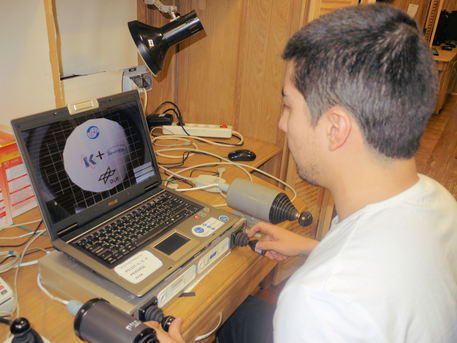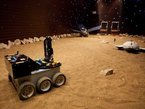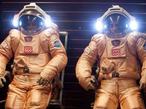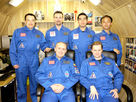The first full-duration simulation
Mars500 ‘arrives’ in orbit around Mars
The first full-duration simulation of a manned voyage to Mars has reached a major milestone: the ‘spacecraft’ yesterday ‘arrived’ at Mars after 244 days of virtual interplanetary flight. Three crewmembers will ‘land’ on Mars on 12 February and make three sorties onto simulated martian terrain.
 © ESA |
Diego Urbina with a computer simulation in the Mars500 facility.
Mars500, a pioneering international study of the complex psychological and technical issues that must be tackled for long spaceflights, has been running for more than eight months in hermetically sealed modules imitating a Mars spacecraft at the Institute of Biomedical Problems (IBMP) in Moscow.
The crew of three Russians, two Europeans and one Chinese has been living and working in the facility like a real expedition to Mars. They are following a similar seven-day week, with two days off duty, to the astronauts on the International Space Station. Their work time during the ‘flight’ is filled with maintenance jobs, experiments and daily exercise.
“Mars500 is a visionary experiment,” notes Simonetta Di Pippo, ESA Director for Human Spaceflight. “Europe is getting ready to make a step further in space exploration: our technology and our science grow stronger every day.
“Mars 500 today is only an enriching simulation, but we are working to make it real.”
The crew of three Russians, two Europeans and one Chinese has been living and working in the facility like a real expedition to Mars. They are following a similar seven-day week, with two days off duty, to the astronauts on the International Space Station. Their work time during the ‘flight’ is filled with maintenance jobs, experiments and daily exercise.
“Mars500 is a visionary experiment,” notes Simonetta Di Pippo, ESA Director for Human Spaceflight. “Europe is getting ready to make a step further in space exploration: our technology and our science grow stronger every day.
“Mars 500 today is only an enriching simulation, but we are working to make it real.”
Mars now – but virtually
Yesterday, the craft ‘entered a circular orbit around Mars’ – as the mission scenario says.The final approach began on 24 December by shifting their imagined trajectory from interplanetary space to a spiral orbit leading down to the vicinity of the Red Planet.
The crew opened the hatch between the mothership and the mockup of a lander that, according to script, was launched separately to Mars.
In the coming days, the cargo inside the ‘lander’ will be transferred into the habitat and the lander will be prepared for ‘undocking’ and ‘landing’.
The crew will then divide: Russian Alexandr Smoleevskiy, Italian Diego Urbina and Chinese Wang Yue will enter the lander, while the rest of the crew, Romain Charles from France and Sukhrob Kamolov and Alexey Sitev from Russia ‘remain in orbit’.
The hatch between the interplanetary spacecraft and lander will be closed on 8 February. The lander will undock and ‘touch down’ on Mars on 12 February.
Going out
The first sortie onto the simulated martian surface, housed in a large hall alongside the Mars500 modules, will happen on 14 February: Alexandr Smoleevskiy and Diego Urbina will don the modified Russian Orlan spacesuits and exit the lander’s airlock.The next sortie – by Smoleevskiy and Wang Yue – will take place on 18 February, and the last one – by Smoleevskiy and Urbina – is scheduled for 22 February.
On 23 February, the lander will be launched to ‘orbit’ and dock with the mothership on following day.
The lander crew will stay in quarantine for three days before the hatch is opened on 27 February and the astronauts are reunited.
Still more than 200 days to go
On 28 February the lander will be loaded with rubbish and unwanted items and the vehicle will be ‘abandoned’. This will happen 1 March, just before the spacecraft spirals away from Mars by virtually firing its engines.After that, the crew is faced with another monotonous ‘interplanetary cruise’ before arriving home in early November 2011.
The first full-duration simulation
Mars500 ‘arrives’ in orbit around Mars
The first full-duration simulation of a manned voyage to Mars has reached a major milestone: the ‘spacecraft’ yesterday ‘arrived’ at Mars after 244 days of virtual interplanetary flight. Three crewmembers will ‘land’ on Mars on 12 February and make three sorties onto simulated martian terrain.
 © ESA |
Diego Urbina with a computer simulation in the Mars500 facility.
Mars500, a pioneering international study of the complex psychological and technical issues that must be tackled for long spaceflights, has been running for more than eight months in hermetically sealed modules imitating a Mars spacecraft at the Institute of Biomedical Problems (IBMP) in Moscow.
The crew of three Russians, two Europeans and one Chinese has been living and working in the facility like a real expedition to Mars. They are following a similar seven-day week, with two days off duty, to the astronauts on the International Space Station. Their work time during the ‘flight’ is filled with maintenance jobs, experiments and daily exercise.
“Mars500 is a visionary experiment,” notes Simonetta Di Pippo, ESA Director for Human Spaceflight. “Europe is getting ready to make a step further in space exploration: our technology and our science grow stronger every day.
“Mars 500 today is only an enriching simulation, but we are working to make it real.”
The crew of three Russians, two Europeans and one Chinese has been living and working in the facility like a real expedition to Mars. They are following a similar seven-day week, with two days off duty, to the astronauts on the International Space Station. Their work time during the ‘flight’ is filled with maintenance jobs, experiments and daily exercise.
“Mars500 is a visionary experiment,” notes Simonetta Di Pippo, ESA Director for Human Spaceflight. “Europe is getting ready to make a step further in space exploration: our technology and our science grow stronger every day.
“Mars 500 today is only an enriching simulation, but we are working to make it real.”
Mars now – but virtually
Yesterday, the craft ‘entered a circular orbit around Mars’ – as the mission scenario says.The final approach began on 24 December by shifting their imagined trajectory from interplanetary space to a spiral orbit leading down to the vicinity of the Red Planet.
The crew opened the hatch between the mothership and the mockup of a lander that, according to script, was launched separately to Mars.
In the coming days, the cargo inside the ‘lander’ will be transferred into the habitat and the lander will be prepared for ‘undocking’ and ‘landing’.
The crew will then divide: Russian Alexandr Smoleevskiy, Italian Diego Urbina and Chinese Wang Yue will enter the lander, while the rest of the crew, Romain Charles from France and Sukhrob Kamolov and Alexey Sitev from Russia ‘remain in orbit’.
The hatch between the interplanetary spacecraft and lander will be closed on 8 February. The lander will undock and ‘touch down’ on Mars on 12 February.
Going out
The first sortie onto the simulated martian surface, housed in a large hall alongside the Mars500 modules, will happen on 14 February: Alexandr Smoleevskiy and Diego Urbina will don the modified Russian Orlan spacesuits and exit the lander’s airlock.The next sortie – by Smoleevskiy and Wang Yue – will take place on 18 February, and the last one – by Smoleevskiy and Urbina – is scheduled for 22 February.
On 23 February, the lander will be launched to ‘orbit’ and dock with the mothership on following day.
The lander crew will stay in quarantine for three days before the hatch is opened on 27 February and the astronauts are reunited.
Still more than 200 days to go
On 28 February the lander will be loaded with rubbish and unwanted items and the vehicle will be ‘abandoned’. This will happen 1 March, just before the spacecraft spirals away from Mars by virtually firing its engines.After that, the crew is faced with another monotonous ‘interplanetary cruise’ before arriving home in early November 2011.











